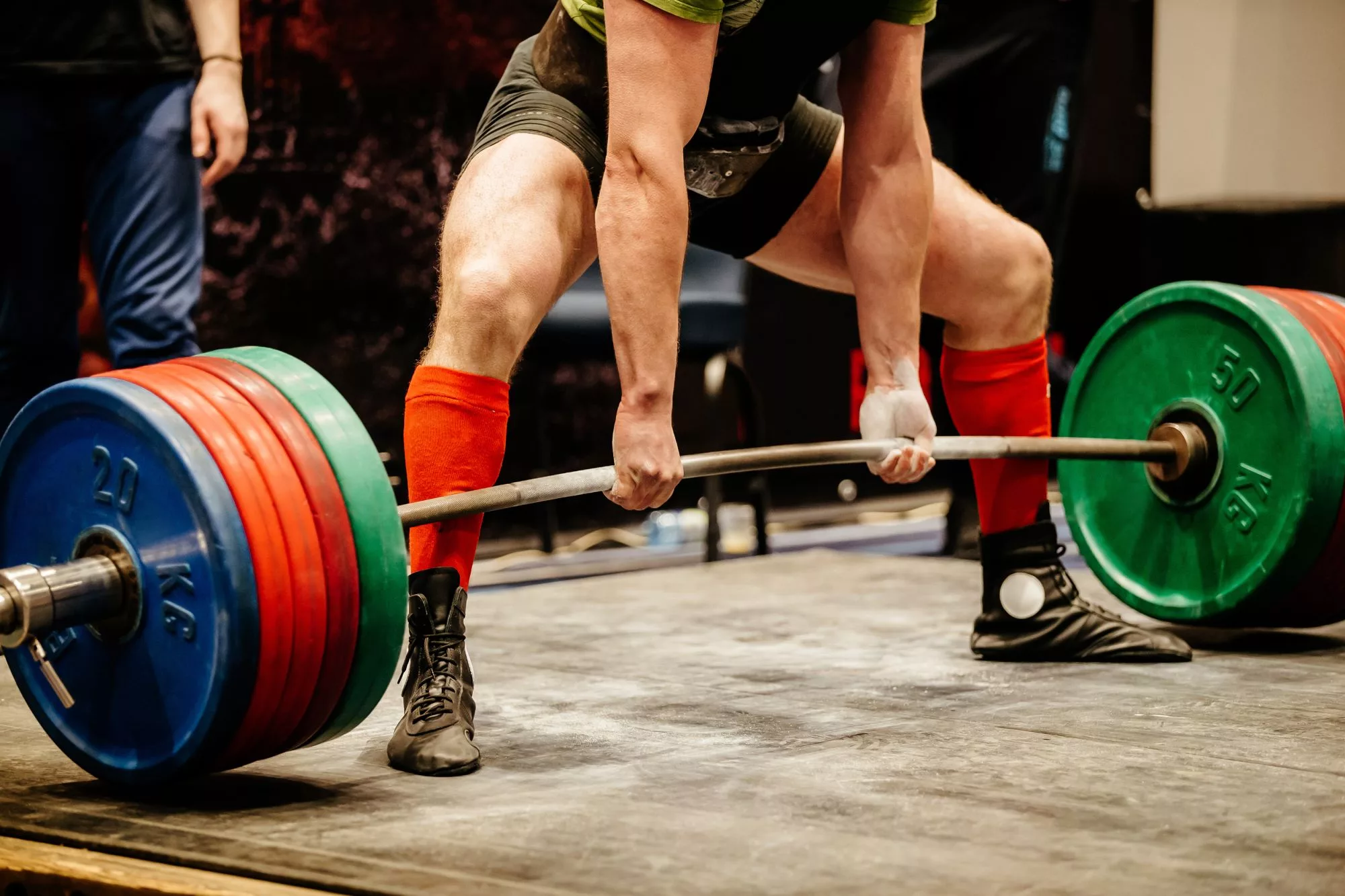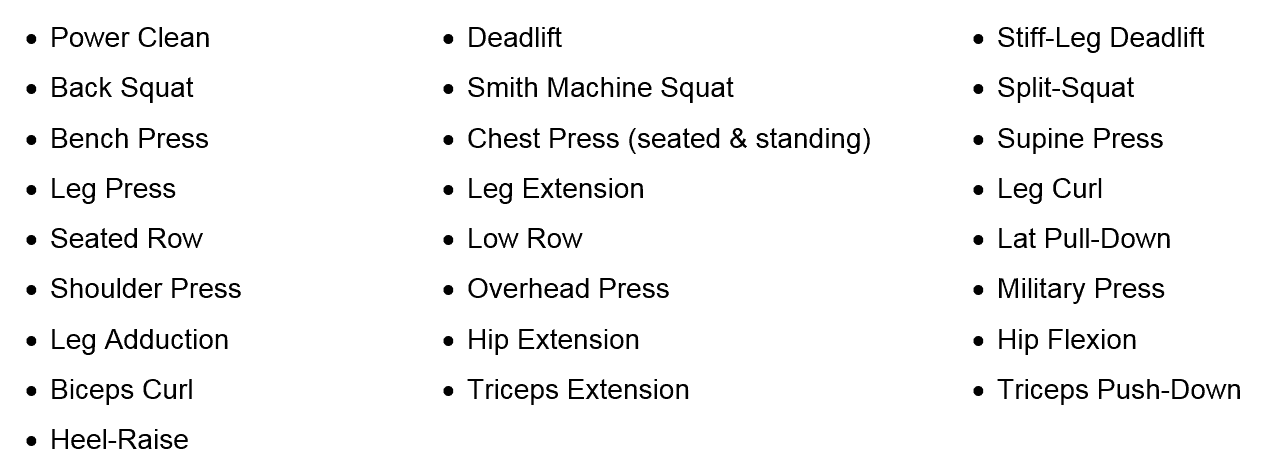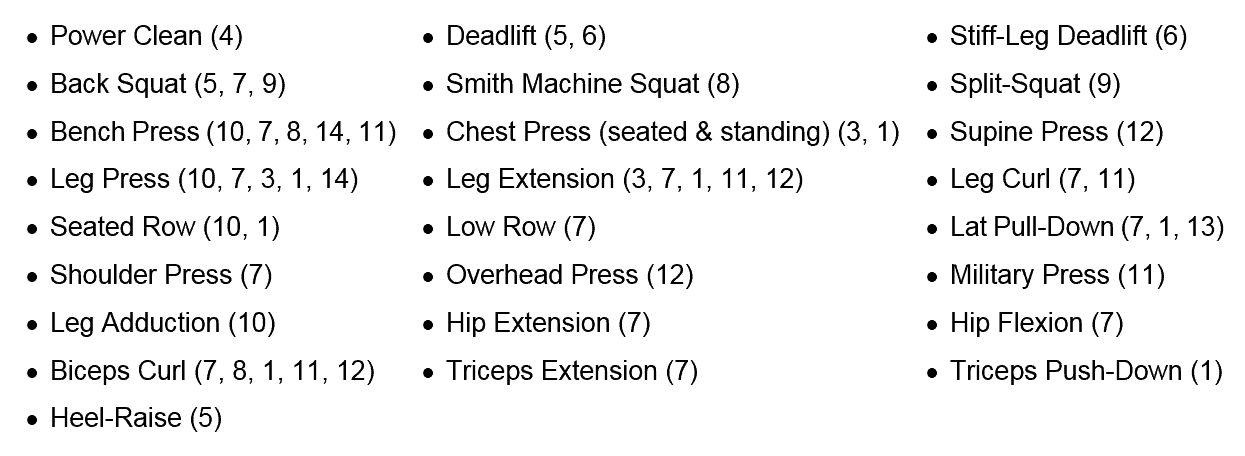Table of Contents
- Summary
- What is one-repetition maximum (1RM) testing?
- Who should use 1RM testing?
- How do you conduct 1RM testing?
- How do you score the 1RM test?
- Considerations for using 1RM testing
- Is 1RM testing valid and reliable?
- Conclusion
- About the Author
- References
Summary
Considered the ‘gold-standard’ test for measuring maximum strength or explosive strength in non-laboratory environments, the one-repetition maximum (1RM) test can be conducted on a large variety of populations, from children aged 6+ years, to middle-aged patients with coronary heart disease. Moreover, the 1RM test has been proven as a valid and reliable measure of performance in all the exercises listed below:
What is one-repetition maximum (1RM) testing?
The 1RM test is often considered the ‘gold standard’ for assessing the strength capacity of individuals in non-laboratory environments (1). It is simply defined as the maximal weight an individual can lift for only one repetition with correct technique. The 1RM test is most commonly used by strength and conditioning coaches to assess strength capacities, strength imbalances, and to evaluate the effectiveness of training programmes (2).
Despite previous concerns, various 1RM tests have been shown to be a safe and reliable measure of strength in young children (6-12 years) (3), adolescent athletes (15-17 years) (4), healthy trained and untrained adults (18-36 years) (5, 6, 7, 8, 9), untrained middle-aged individuals (50-52 years) (1), post-menopausal women (54-60 years) (10), patients with cardiovascular disease (11, 12), and individuals aged 75+ (13, 14). As this test is simple, time effective, inexpensive, and reliable, it is a very popular testing protocol (15).
The diversity of the 1RM test means it is not limited to only one exercise. Instead, it can be conducted using a wide variety of exercises such as: back squat, leg press, leg extension, leg curl, bench press, chest press, lat pull-down, seated low row, and the Olympic Clean – to name just a few. Though previous research has been conducted on these exercises, it is important to ensure the exercise you wish to use has been proven as a reliable predictor of 1RM for your chosen population before conducting your test.
For example, whilst the safety and reliability of 1RM back squat testing has been proven in healthy young adults (7), no research to our knowledge has demonstrated that this is a safe and reliable predictor in individuals 75 years and over. However, although the 1RM back squat has not been proven to be safe and reliable in the elderly population, exercises such as the lat pull-down and the bench press have been (13, 14). Therefore, knowing that your chosen exercise is both a valid and reliable measure of 1RM strength before conducting the test is vital.
IMPORTANT: It has been suggested novice lifters should not perform a 1RM strength test, simply because lifting maximal weight by individuals not accustomed to weight training may induce large degrees of muscle soreness and increase the risk of a more serious injury (2, 16).
Who should use 1RM testing?
Though the 1RM test is primarily used to measure maximal strength capacities, it can also be used to measure force-time, power-time, and velocity-time characteristics when performed using specialised equipment such as a force plate. As strength is a vital ingredient in sports performance, optimising an athlete’s strength capacity is often very beneficial (17, 18, 19). Therefore, testing your athlete’s 1RM before and after your prescribed training programme can be a useful indicator of the effectiveness of the programme.
Likewise, it can also be used consecutively throughout the programme to ensure improvements in strength are always being made and to avoid training stagnation. As a result, 1RM testing can be administered for any athlete or individual for whom you deem it to be important for, and as a useful marker of physical improvement. Furthermore, it can also be useful to calculate relative strength (kg lifted per kg of body weight) when comparing the strength abilities between multiple athletes/individuals.
How do you conduct 1RM testing?
Equipment Requirements
Before the start of the test, it is important to ensure you have the following items:
- Reliable and consistent testing facility (e.g. gym or laboratory).
- Free weights or machine
- Test administrator x 2 (one acts as a spotter, whilst the other assesses and records performances)
- Stopwatch
- Performance recording sheet
NOTE: It is important to understand that whenever fitness testing is performed, it must be done in a consistent environment (e.g. facility) so it is protected from varying weather types, and with a dependable surface that is not affected by wet or slippery conditions. If the environment is not consistent, the reliability of repeated tests at later dates can be substantially hindered and result in worthless data.
Various test methods
Over the years, numerous ways to conduct the 1RM test have been used, the protocol explained in this article corresponds to the methods used in a large majority of recent research (1, 3, 7, 8, 9, 13, 14).
Throughout the research, various rest times have been used when performing the 1RM test. Whilst some studies have used only 1-2 minute rest periods between 1RM attempts (3, 13, 14, 1, 7), others have used 3-5 minutes (8, 9). Though a rest period of 1-2 minutes between a maximal-effort anaerobic exercise (i.e. a 1RM test) appears counterproductive, the studies appear to have produced valid and reliable results.
Consequently, it is simply recommended that when conducting 1RM testing, the strength and conditioning coach selects a preferred rest duration (between 1-5 minutes) and continuously and consistently keeps to that time until further research clarifies this issue.
Furthermore, some researchers used the CR10 Borg Scale (20) to determine the duration of the participants’ rest periods (13, 14). Participants were allowed to rest for one minute if they rated the effort ≤ 3 on the CR10 Borg Scale. If the effort was rated as ≥ 4, then participants would be allowed a two-minute rest period. Those these rest periods appear short, the researchers still concluded that these tests were both valid and reliable. It is however extremely important to note that these 1RM tests were conducted on older adults (75+ years).
Test Procedure
Calculate body mass (kg)
Participants must be weighed in lightweight clothing with shoes and accessories removed.
Starting the test
- The participant should perform a warm-up with a self-selected load that will allow them to complete a minimum of 6-10 repetitions (approx. 50 % predicted 1RM).
- 1-5 minute rest (decided by test administrator).
- Participants then select a weight based on the previous effort which allows them to perform three repetitions (approx. 80% of predicted 1RM).
- 1-minute rest (decided by test administrator).
- Participants now increase the load and begin attempting their 1RM. A series of single attempts should be completed until a 1RM is achieved.
- Rest periods should remain at 1-5 minutes between each single attempt and load increments typically range between 5-10 % for the upper-body, and 10-20 % for the lower-body exercises. 1RMs should be achieved within 3-7 attempts.
- If multiple 1RM tests are being administered (e.g. back squat, bench press, and deadlift), then it is recommended that all test exercises should be separated by a 3-5 minute rest period.
- NOTE: It is essential that the test administrator follows the exact same testing procedure at every successive test throughout the training programme. This ensures that the previous testing data/information can be used and compared against future tests.
How do you score the 1RM test?
This is simply done by recording the individual’s total weight lifted in kilograms or pounds. This figure will give you their maximal strength for that particular exercise.
For example:
- Maximal Strength (kg) = total weight lifted (e.g. 100 kg back squat).
In the case of measuring an explosive exercise such as the power clean, this figure will display an athlete’s maximal explosive strength.
For example:
- Maximal explosive strength (kg) = total weight lifted (e.g. 100 kg power clean).
Relative strength is also a useful measure as it allows you to tentatively compare the performances of multiple athletes. This variable provides a less biased value in comparison to maximum strength – though not perfect – for comparing scores between a group of athletes. Relative strength is how much weight an individual can lift per kilogram of body weight (kg lifted per kg of body weight).
- Relative Strength (kg · BW) = total weight lifted (kg) ÷ body mass (kg).
Considerations for using 1RM testing
When conducting the 1RM test, there are several factors that need to be taken into consideration before you begin – some being:
- Full range of movement (exercise dependent) – It is essential that the participant achieves a full range of movement with proficiency for the 1RM lifted to be valid. However, you MUST note that if testing a parallel squat then this still applies, but in this instance, it refers to only achieving a full range of movement into the parallel squat and not above (e.g. 1/4 squat) or below (e.g. full squat). So if you are testing the parallel squat, then you must ensure the athlete achieves a parallel squat with technical competency.
- Injuries – before conducting any 1RM test, it is vital the athletes are deemed injury-free. When working with individuals suffering from any medical condition, it is highly recommended that consent is provided by a medical professional (i.e. doctor).
- Circadian rhythms – circadian rhythms can significantly alter power outputs during such anaerobic performance tests (21). Current knowledge suggests that an early morning anaerobic test will elicit significantly lower peak power values than a late afternoon or evening test.
- Individual effort – Sub-maximal efforts can result in inaccurate and meaningless scores.
Is 1RM testing valid and reliable?
Various 1RM tests have been shown to be a safe and reliable measure of strength in various populations:
- Young children (6-12 years) (3)
- Adolescent athletes (15-17 years) (4).
- Healthy trained and untrained adults (18-36 years) (7, 8, 9)
- Untrained middle-aged individuals (50-52 years) (1)
- Post-menopausal women (54-60 years) (10)
- Patients with cardiovascular disease (11, 12)
- Individuals aged 75+ (13, 14).
The exercises used throughout these studies and shown to be reliable are:
Conclusion
The 1RM test appears to be a valid and reliable measure of performance in a large variety of populations. What’s more, the test also appears to be extremely diverse and can be conducted reliably on an assortment of exercises. It is however mandatory that these tests are only conducted by qualified and experienced personnel.
- Levinger, I., Goodman, C., Hare, D.L., Jerums, G., Toia, D. and Selig, S. (2009) The reliability of the 1RM strength test for untrained middle-aged individuals. Journal of Science and Medicine in Sport 12 (3), 310-316 [PubMed]
- Braith, R.W., Graves, J.E., Leggett, S.H. and Pollock, M.L. (1993) Effect of training on the relationship between maximal and submaximal strength. Medicine and Science in Sports and Exercise 25, 132-138. [PubMed]
- Faigenbaum, A.D., Milliken, L.A., & Westcott, W.L. (2003). Maximal strength testing in healthy children. Journal of Strength and Conditioning Research, 17(1), 162-166. [PubMed]
- Faigenbaum, AD, McFarland, JE, Herman, RE, Naclerio, F, Ratamess, NA, Kang, J, and Myer, GD. (2012). Reliability of the one repetition-maximum power clean test in adolescent athletes Journal of Strength and Conditioning Research 26(2): 432–437. [PubMed]
- English, K. L., Loehr, J. A., Laughlin, M. A., Lee, S. M., & Hagan, R. D. (2008). Reliability of strength testing using the advanced resistive exercise device and free weights. NASA Technical Paper, 214728. [Link]
- Bezerra, E. S., Simão, R., Fleck, S. J., Paz, G., Maia, M., Costa, P. B., & Serrão, J. C. (2013). Electromyographic Activity of Lower Body Muscles during the Deadlift and Still-Legged Deadlift. Journal of Exercise Physiology Online, 16(3). [Link]
- Seo, Dong-il., Eonho, K., Fahs, C.A., et al. (2012). Reliability of the one-repetition maximum test based on muscle group and gender. Journal of Sports Science and Medicine. 11, 221-225. [PubMed]
- Ribeiro, A.S., Nasimento, M.A., Salavador, E.P., et al. (2013). Reliability of one-repetition maximum test in untrained young adult men and women. Isokinetics and Exercise Science, 22, 175-182. [PubMed]
- Urquhart, BG, Moir, GL, Graham, SM, and Connaboy, C. Reliability of 1RM split-squat performance and the efficacy of assessing both bilateral squat and split-squat 1RM in a single session for non–resistance-trained recreationally active men. J Strength Cond Res 29(7): 1991–1998, 2015 [Link]
- Kemmler, W.K., D. Lauber, A. Wasserman, and J.L. Mayhew. Predicting maximal strength in trained postmenopausal women. J. Strength Cond. Res. 20(4):838–842. 2006. [PubMed]
- Ghilarducci LEC, Holly RG, Amsterdam EA. Effects of high resistance training in coronary artery disease. Am J Cardiol 1989;64:866—70. [PubMed]
- Featherstone JF, Holly RG, Amsterdam EA. Physiologic responses to weight lifting in coronary artery disease. Am J Cardiol 1993;71:287—92. [PubMed]
- Karlsson, E.R.C., Frandin, K., & Akner, G. (2007). Muscle strength testing with one repetition maximum in the arm/shoulder for people aged 75+ – test-retest reliability. Clinical Rehabilitation, 21, 258-265. [PubMed]
- Phillips WT, Batterham AM, Julie E, Valenzuela JE, Burkett LN. Reliability of maximal strength testing in older adults. Arch Phys Med Rehabil 2004; 85: 329-334. [PubMed]
- Kraemer, W.J., Ratamess, N.A., Fry, A.C. and French, D.N. (2006) Strength training: development and evaluation of methodology. In: Physiological assessment of human fitness. Eds: Maud P.J. and Foster, C. Champain, IL: Human Kinetics. [Link]
- Dohoney, J., Chromiak, D., Lemire, B.R., Kovacs, A., & Kovacs, C. (2002). Prediction of one repetition maximum (1-rm) strength from a 4-6 rm and a 7-10 rm submaximal strength test in healthy young adult males. Journal of exercise physiology. 5(3), 54-59. [Link]
- Wisloff, U., Castagna, C., Helgerud, J., Jones, R., & Hoff, J. (2004). Strong correlation of maximal squat strength with sprint performance and vertical jump height in elite soccer players. British Journal of Sports Medicine, 38(3), 285–288. [PubMed]
- Comfort, P, Stewart, A, Bloom, L, and Clarkson, B. Relationships between strength, sprint, and jump performance in well-trained youth soccer players. J Strength Cond Res 28(1): 173–177, 2014. [PubMed]
- Sander, A., Keiner, M., Wirth, K., & Schmidtbleicher, D. (2013). Influence of a 2-year strength training programme on power performance in elite youth soccer players. European Journal of Sport Science, 13(February), 445–51. [PubMed]
- Borg GA. Psychophysical bases of perceived exertion. Med Sci Sports Exerc 1982; 14: 37781. [PubMed]
- Teo, W., Newton, M.J., & McGuigan, M.R. (2011). Circadian rhythms in exercise performance: Implications for hormonal and muscular adaptation. Journal of Sports Science and Medicine, 10, pp.600-606. [PubMed]






